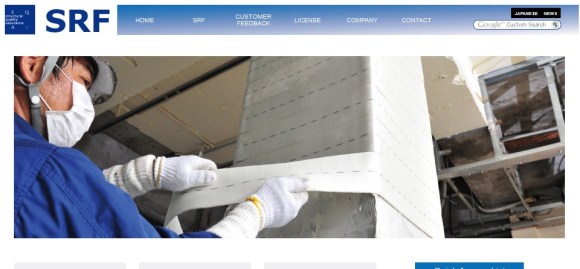
Dr. Shunichi Igarashi has surprised even himself with his line of Super Reinforcement with Flexibility (SRF) technology. SRF basically involves wrapping the columns and walls of building in adhesive strips.
The idea of gluing fabric on a building to protect it from the sheer force of an earthquake doesn’t sound very comforting. However, when Dr. Igarashi’s SRF was put to the test in the Great Tohoku Earthquake on 11 March, 2011, it passed with flying colors.
The process of SRF is actually as simple as it sounds. Just expose the surface of a pillar, apply a specially designed solvent-free adhesive and wrap the strips of fabric tightly around the column. Repeat if necessary, and your building becomes stronger.
It’s so simple that organizations that are too important to close down such as hospitals and RocketNews24 Towers can continue functioning at full capacity while the renovation is being done. The adhesive has no odors or fumes and the process is quiet.
Dr. Igarashi came up with the idea while in Turkey. He had worked there before but immediately returned following the 1999 İzmit Earthquake. He and a group of students inspected the remaining building and determined those fit for use.
Unfortunately, a few months later, an almost equally strong aftershock hit killing his students when their dormitory collapsed.
Dr. Igarashi was devastated by this and remained holed up in his hotel room. Then one morning he began to feel an earthquake. As he was bracing himself he saw a column in front of him that was wavering but undamaged by the quake. It was wrapped in a white bandage. Then he awoke from his dream.
His initial thought was that reinforced concrete is like a body. The iron bars are like the skeleton and the concrete is like flesh. Together they are strong but if one part begins to fail then the structure quickly comes undone.
In that sense taping up pillars in a building would be just like an athlete taping up their arms, legs, etc. Covering reinforcement has already been done with steel which does improve strength.
However, the rigid strength of the steel transferred the strain of the vibrations to the uncovered areas such as joints. This can still make the overall structure highly dangerous following a quake.
The bandages of SRF can withstand 16 tons of strength per 4mm layer but bend with the concrete just enough to absorb the energy and prevent dangerous cracking.
Once the design was complete, Dr. Igarashi installed SRF in various buildings across Japan including four in Sendai City.
■ The Sakurano Department Store was reinforced with SRF in 2010. It was also one of the earliest businesses to reopen after 11 March. It was functioning less than a month after.
■ Another small store in Sendai could remain in business after the earthquake of 2011 while other stores around it either had to be closed or collapsed.
■ An elementary school was reinforced in 2007 and could reopen earlier than neighboring schools.
■ Owners of an apartment building which was deemed up to code for earthquake prevention decided to invest in some extra security with SRF. Following the earthquake even the tiles of the building remained in place.
These results were even surprising to the makers of the material. It was later determined that in addition to supporting the reinforced concrete, SRF actually helped to dampen the seismic waves of the earthquake giving it another level of protection.
On top of that, some companies have reported that the strips also act as insulation, lowering the utility costs for heating and cooling. It can also be used on wooden structures.
It’s a job well done for Dr. Igarashi and his team and one he says he will continue to improve on. Johnson & Johnson should also thank him for putting a positive spin on “Band-Aid solution.”
Source: SRF (English) via Nikkei Business Online (Japanese)
▼ A video demonstrating how easy it is to install SRF